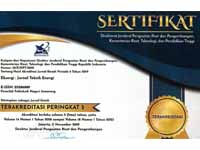Evaluation of Fill Pack Damage to the Cooling Effectiveness of Counter Flow Type Cooling Tower in the Oil and Gas Industry
DOI:
https://doi.org/10.32497/eksergi.v20i03.6347Abstract
In the oil and gas industry, cooling water is needed to cool various kinds of heat-generating equipment and as a backup water requirement. Cooling water in the industry is usually produced by cooling towers in large quantities. The working principle of the cooling tower by exchanging heat from the hot water of a process with exhaled cold air. There is a cooling tower part called a fill pack and has an important function as a place for heat exchange between water and air. In this research in the oil and gas industry, the cooling tower used is a wet cooling tower type with counter flow flow. The purpose of this study is to determine the current cooling effectiveness of the cooling tower compared to its design data. Calculating the effectiveness of cooling certainly requires water temperature data produced by the cooling tower. The method used in this research is the method of taking water temperature data before and after leaving the cooling tower. The level of cooling effectiveness in the cooling tower will be better if the water temperature produced is cooler than the water temperature when entering the cooling tower.
References
[1] M. Azis, J. Albar, and I. Nuhardin, “Evaluasi Kinerja Cooling Tower Type Induced Draft Counter Flow Pada Sirkulasi Air Jernih Industri Baja Performance Evaluation of Cooling Tower Type Induced Draft Counter Flow in Steel Industry Clear Water Circulation counter flow pada sirkulasi air jernih,” vol. 9, no. 1, pp. 1–10, 2024.
[2] Pertamina Persero RU VI Balongan, “Pengelolaan Lingkungan Ptpertamina ( Persero ) Ru Vi Balongan,” 2017.
[3] I. K. G. Sastrawan and R. Subagyo, “ANALISA PERPINDAHAN PANAS COOLING TOWER (INDUCED DRAFT) PLTU I PULANG PISAU (2 x 60 MW),” Jtam Rotary, vol. 2, no. 2, p. 171, 2020, doi: 10.20527/jtam_rotary.v2i2.2413.
[4] M. M. El-Wakil, Instalasi Pembangkit Daya. Penerbit Erlangga, 2021.
[5] R. Rahman and A. Mursadin, “Analisis Kinerja Cooling Tower Menggunakan Metode Range Dan Approach Di Pltu Asam-Asam,” Jtam Rotary, vol. 4, no. 2, p. 129, 2022, doi: 10.20527/jtam_rotary.v4i2.6411.
[6] A. Nurrahman, Zami Furqon, Farid Alfalaki Hamid, and Muhammad Iqbal Al Haritsah, “Cooling Tower Performance Efficiency in Water Treatment Unit at PT. X Sukowati,” J. Ilm. Tek. Kim., vol. 8, no. 1, pp. 15–23, 2024, doi: 10.32493/jitk.v8i1.35469.
[7] L. P. I. Midiani, I. W. Temaja, I. P. M. Adnyana, I. K. Dwiana, and I. M. P. Yoga, “Analisa kinerja cooling tower tipe counter flow induced draft,” J. Appl. Mech. Eng. Green Technol., vol. 2, no. 2, pp. 72–77, 2021, doi: 10.31940/jametech.v2i2.2712.
[8] T. Pipit Muliyah, Dyah Aminatun, Sukma Septian Nasution, Tommy Hastomo, Setiana Sri Wahyuni Sitepu, “Laporan Tugas Khusus Praktek Kerja Lapangan,” J. GEEJ, vol. 7, no. 2, pp. 22–28, 2020.
[9] A. U. Sulis Yulianto, “Perancangan Cooling Tower Untuk Alat Penukar Kalor Shell and Tube Kapasitas Skala Laboratorium,” Sintek, vol. 7, no. 1, pp. 1–11, 2013.
[10] Asiva Noor Rachmayani, “Towards Asia’s Leading Refinery in 2025,” p. 6, 2015.
[11] Mutiara Ghinaul Qalbi, Budi Suharto, and Sri Wuryanti, “Analisis Efektivitas Cooling Tower Sebelum dan Sesudah Pergantian Filler Pack,” J. Surya Tek., vol. 11, no. 1, pp. 394–399, 2024, doi: 10.37859/jst.v11i1.7326.
[12] P. Ahluriza and N. Sinaga, “Review Pengaruh Range Dan Approach Terhadap Efektivitas Cooling Tower di PT. IP,” J. Pendidik. Tek. Mesin Undiksha, vol. 9, no. 2, pp. 134–142, 2021, doi: 10.23887/jptm.v9i2.34899.
[13] S. A. Fatin, “Analisis Kinerja Cooling Tower Pada Pltgu Di Pabrik Semen X,” pp. 938–946, 2023.
[14] A. S. Anugrah, F. A. Firmansyah, R. A. Ilhamsyah, and M. F. Umam, “Analisis Kinerja Natural Draft Cooling Tower di Unit Kilang Pusat Pengembangan Sumber Daya Manusia Minyak dan Gas Bumi,” Maj. Ilm. Swara Patra, vol. 11, no. 1, pp. 1–13, 2021, doi: 10.37525/sp/2021-1/270.
[15] A. Permana, A. S. Margana, and W. S. Ayu, “Analisis Efektivitas Cooling Towersebelum Dan Sesudah Perawatan Di Istana BEC Bandung,” Pros. Ind. Res. Work. Natl. Semin., vol. 14, no. 1, pp. 507–510, 2023, doi: 10.35313/irwns.v14i1.5437.
Downloads
Published
Issue
Section
License
Copyright (c) 2024 Anis Roihatin, Nabila Aida Az Zahro

This work is licensed under a Creative Commons Attribution 4.0 International License.
Authors who publish with this journal agree to the following terms:Authors retain copyright and grant the journal right of first publication with the work simultaneously licensed under a Creative Commons Attribution License that allows others to share the work with an acknowledgement of the work's authorship and initial publication in this journal.
Authors are able to enter into separate, additional contractual arrangements for the non-exclusive distribution of the journal's published version of the work (e.g., post it to an institutional repository or publish it in a book), with an acknowledgement of its initial publication in this journal.
Authors are permitted and encouraged to post their work online (e.g., in institutional repositories or on their website) prior to and during the submission process, as it can lead to productive exchanges, as well as earlier and greater citation of published work (See The Effect of Open Access).






